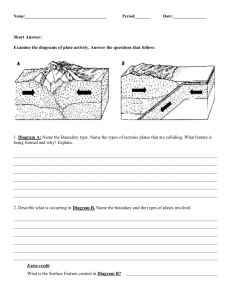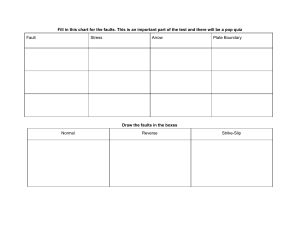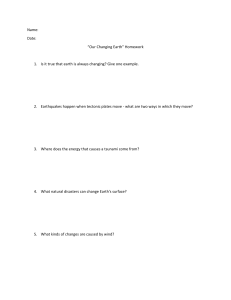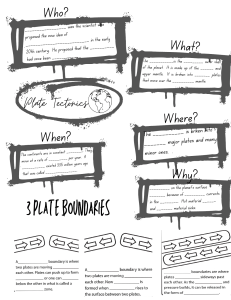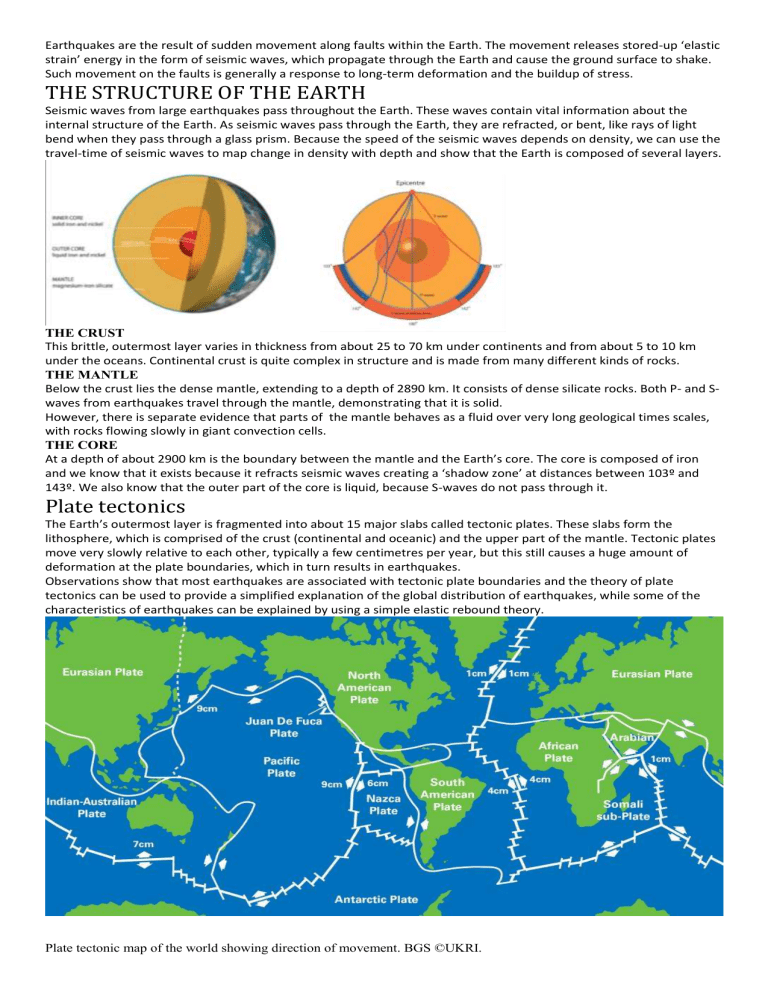
Earthquakes are the result of sudden movement along faults within the Earth. The movement releases stored-up ‘elastic strain’ energy in the form of seismic waves, which propagate through the Earth and cause the ground surface to shake. Such movement on the faults is generally a response to long-term deformation and the buildup of stress. THE STRUCTURE OF THE EARTH Seismic waves from large earthquakes pass throughout the Earth. These waves contain vital information about the internal structure of the Earth. As seismic waves pass through the Earth, they are refracted, or bent, like rays of light bend when they pass through a glass prism. Because the speed of the seismic waves depends on density, we can use the travel-time of seismic waves to map change in density with depth and show that the Earth is composed of several layers. THE CRUST This brittle, outermost layer varies in thickness from about 25 to 70 km under continents and from about 5 to 10 km under the oceans. Continental crust is quite complex in structure and is made from many different kinds of rocks. THE MANTLE Below the crust lies the dense mantle, extending to a depth of 2890 km. It consists of dense silicate rocks. Both P- and Swaves from earthquakes travel through the mantle, demonstrating that it is solid. However, there is separate evidence that parts of the mantle behaves as a fluid over very long geological times scales, with rocks flowing slowly in giant convection cells. THE CORE At a depth of about 2900 km is the boundary between the mantle and the Earth’s core. The core is composed of iron and we know that it exists because it refracts seismic waves creating a ‘shadow zone’ at distances between 103º and 143º. We also know that the outer part of the core is liquid, because S-waves do not pass through it. Plate tectonics The Earth’s outermost layer is fragmented into about 15 major slabs called tectonic plates. These slabs form the lithosphere, which is comprised of the crust (continental and oceanic) and the upper part of the mantle. Tectonic plates move very slowly relative to each other, typically a few centimetres per year, but this still causes a huge amount of deformation at the plate boundaries, which in turn results in earthquakes. Observations show that most earthquakes are associated with tectonic plate boundaries and the theory of plate tectonics can be used to provide a simplified explanation of the global distribution of earthquakes, while some of the characteristics of earthquakes can be explained by using a simple elastic rebound theory. Plate tectonic map of the world showing direction of movement. BGS ©UKRI. What drives the movement of tectonic plates? Below the tectonic plates lies the Earth’s asthenosphere. The asthenosphere behaves like a fluid over very long time scales. There are a number of competing theories that attempt to explain what drives the movement of tectonic plates. Three of the forces that have been proposed as the main drivers of tectonic plate movement are: mantle convection currents: warm mantle currents drive and carry plates of lithosphere along a like a conveyor belt ridge push (buoyant upwelling mantle at mid-ocean ridges): newly formed plates at oceanic ridges are warm, so they have a higher elevation at the oceanic ridge than the colder, more dense plate material further away; gravity causes the higher plate at the ridge to push away the lithosphere that lies further from the ridge slab pull: older, colder plates sink at subduction zones because, as they cool, they become more dense than the underlying mantle and the cooler, sinking plate pulls the rest of the warmer plate along behind it Research has shown that the major driving force for most plate movement is slab pull, because the plates with more of their edges being subducted are the faster-moving ones. However, ridge push is also presented in recent research to be a force that drives the movement of plates. Mantle convection currents, ridge push and slab pull are three of the forces that have been proposed as the main drivers of plate movement (based on What drives the plates?). BGS © UKRI. All rights reserved. Types of plate boundary There are three types of plated boundary: divergent: plates moving apart convergent: plates coming together transform: plates moving past each other Boundaries between tectonic plates are made up of a system of faults. Each type of boundary is associated with one of three basic types of fault, called normal, reverse and strike-slip faults. DIVERGENT BOUNDARY Plates can move apart at a boundary. This type of boundary is called a divergent boundary. It is also referred to as a constructive plate boundary, as new material is being produced at the boundary surface. This type of boundary is dominated by normal faulting, although other types of faulting may be observed. A divergent, or constructive, plate boundary, where new material is produced at the surface. The Mid-Atlantic Ridge is a good example of a constructive plate boundary. You can see normal faulting at the surface where the Mid-Atlantic Ridge crosses Iceland. BGS ©UKRI. All rights reserved. Hot magma rises from the mantle at mid-ocean ridges, pushing the plates apart. Earthquakes occur along the fractures that appear as the plates move apart. Examples include the East African rift and mid-ocean ridges where two ocean plates are moving apart, such as the regions near the Azores and Iceland. Divergent boundaries are associated with volcanic activity and the earthquakes in these zones tend to be frequent and small. Convergent boundary Continental collisions result in the creation of mountains and fold belts as the rocks are forced upwards. Plates can move towards each other at a boundary. This type of boundary is called a convergent boundary and is dominated by reverse faulting, although other types of faulting may be observed. A convergent, or destructive, boundary showing subduction of an oceanic plate under a continental plate. BGS ©UKRI. All rights reserved. When the boundary is between an oceanic plate and a continental plate, it is also referred to as a destructive plate boundary. At subduction zones, the oceanic plate is pushed down, or subducted, below the continental lithosphere. As the oceanic slab descends, earthquakes are generated within the slab and at the interface between the plates. Destructive plate boundaries include deep ocean trenches like the Peru–Chile trench, where the Nazca plate (an oceanic plate) is being subducted under the South American (continental) plate, i.e. the oceanic plate is forced underneath the continental plate. These boundaries tend to produce most of the earthquakes that have magnitudes greater than 6.0. Subduction zones also produce the deepest earthquakes. Where the boundary is between two continental plates, one plate crumples upwards over the other instead of one plate being subducted. Examples include the boundary between the Eurasian plate and the African plate, forming the Alps, and the boundary between the Indian plate and the Eurasian plate, where the Himalayas are formed where the Eurasian plate is forced up and over the Indian plate. This type of boundary tends to produce a diffuse zone of activity. Continental collisions result in the creation of mountains and fold belts as the rocks are forced upwards. TRANSFORM BOUNDARY Plates can move past each other in the same plane at a boundary. This type of boundary is called a transform boundary. This type of boundary is dominated by strike-slip faulting, although other types of faulting may be observed. Where two plates slide past each other, earthquakes originate at shallow depths. This type of plate boundary is also referred to as a conservative plate boundary, as it involves movement but no loss or creation of material at the surface. Examples include the San Andreas fault in the USA and the Anatolian fault in Asia Minor A transform boundary, where two plates slide past each other in the same plane. Strike-slip faults occur at transform boundaries: for example, a system of strike-slip faults makes up the transform boundary of the San Andreas fault. BGS ©UKRI. Transform boundaries typically produce large, shallow-focus earthquakes. Although earthquakes do occur in the central regions of plates, these regions do not usually have large earthquakes. ELASTIC REBOUND THEORY Elastic rebound theory was originally proposed after the great San Francisco earthquake in 1906 by the geologist Henry Fielding Reid, to explain the deformation caused by earthquakes. Before an earthquake, the buildup of stress in the rocks on either side of a fault results in gradual deformation. Eventually, this deformation exceeds the frictional force holding the rocks together and sudden slip occurs along the fault. This releases the accumulated stress and the rocks on either side of the fault return to their original shape (elastic rebound) but are offset on either side of the fault. Over time stresses in the Earth build up (often caused by the slow movements of tectonic plates). At some point the stresses become so great that the Earth breaks. An earthquake rupture occurs and relieves some of the stresses (but generally not all). BGS ©UKRI. Types of fault There are three basic types of fault: normal, reverse and strike-slip. Certain types of fault are characteristic of the different plate boundaries, although often more than one type of fault occurs there. This can help us understand the relative movement of the plates and the type of deformation. NORMAL FAULT - In a normal fault, the block above the fault moves down relative to the block below the fault. © IRIS. All rights reserved REVERSE FAULT - In a reverse fault, the block above the fault moves up relative to the block below the fault. © IRIS. All rights reserved STRIKE-SLIP FAULT - In a strike-slip fault, the movement of blocks along a fault is horizontal. © IRIS. All rights reserved During an earthquake, the rock on one side of the fault suddenly slips with respect to the other. The fault surface can be horizontal or vertical or some arbitrary angle in between. Faults are classified using the angle of the fault with respect to the surface (known as the dip) and the direction of slip along the fault. Faults that move along the direction of the dip plane are called dip-slip faults while strike-slip faults are classified as either right-lateral or left-lateral. Faults which show both dip-slip and strike-slip motion are known as oblique-slip faults. Boundaries between tectonic plates are made up from a system of faults. Each type of boundary is associated with one of three basic types of fault, called normal, reverse and strike-slip faults. BGS ©UKRI. All rights reserved.
